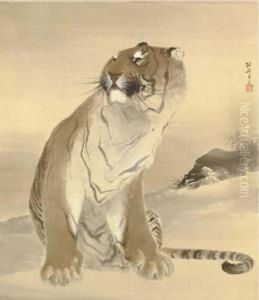Konoshima Okoku Paintings
Konoshima Okoku was a Japanese artist known for his skill in Nihonga, a term referring to traditional Japanese painting techniques. He was born on October 21, 1880, in Kyoto, Japan, during a period when the country was experiencing significant cultural and social changes due to the Meiji Restoration. Okoku was raised in an environment rich in artistic tradition, as Kyoto had been the imperial capital for over a thousand years and was the heart of Japanese culture and art.
Okoku studied under the esteemed Nihonga painter Kikuchi Hobun. Under Hobun's guidance, he learned the intricacies of traditional Japanese painting, which valued the use of natural pigments and adherence to classical themes and techniques. Despite the influence of Western art styles during the Meiji period, Okoku remained dedicated to the traditional methods.
Throughout his career, Okoku developed a distinct style characterized by its serene and refined aesthetic. He often depicted subjects from nature, such as flowers, birds, and landscapes, imbuing them with a subtle elegance and a profound sense of harmony. His works were not only appreciated for their technical excellence but also for their embodiment of the Japanese spirit.
Okoku's contributions to the world of Japanese art were recognized by his contemporaries. He was involved in several important artistic societies, including the Nihon Bijutsuin (Japan Art Institute), which played a crucial role in promoting Nihonga painting during a time of significant Western influence. Despite the challenges of the era, Okoku’s commitment to Nihonga helped ensure that traditional Japanese artistic techniques were preserved and continued to evolve.
Konoshima Okoku passed away on June 24, 1938. His legacy lives on through his artworks, which continue to be celebrated for their beauty and adherence to the aesthetics and philosophies of traditional Japanese art. Okoku's life and work remain a testament to the enduring appeal of Nihonga and its ability to convey the natural beauty and cultural values of Japan.
